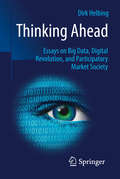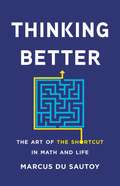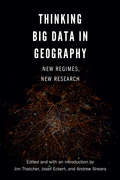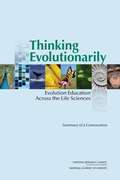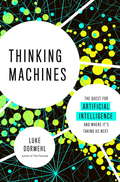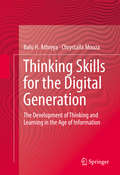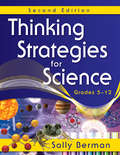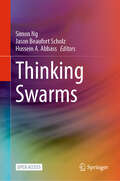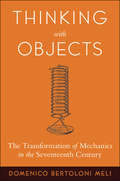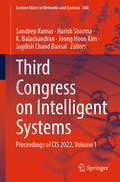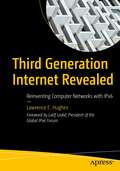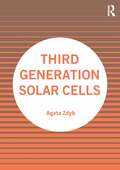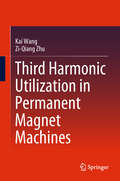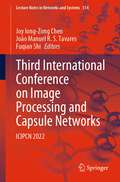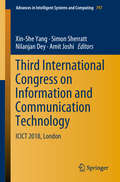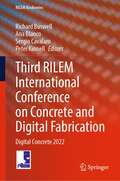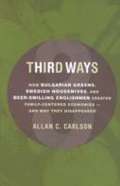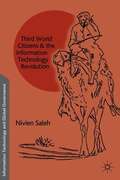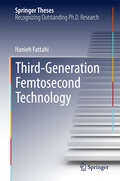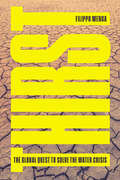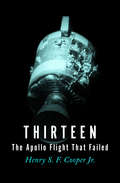- Table View
- List View
Thinking Ahead - Essays on Big Data, Digital Revolution, and Participatory Market Society
by Dirk HelbingThe rapidly progressing digital revolution is now touching the foundations of the governance of societal structures. Humans are on the verge of evolving from consumers to prosumers, and old, entrenched theories – in particular sociological and economic ones – are falling prey to these rapid developments. The original assumptions on which they are based are being questioned. Each year we produce as much data as in the entire human history - can we possibly create a global crystal ball to predict our future and to optimally govern our world? Do we need wide-scale surveillance to understand and manage the increasingly complex systems we are constructing, or would bottom-up approaches such as self-regulating systems be a better solution to creating a more innovative, more successful, more resilient, and ultimately happier society? Working at the interface of complexity theory, quantitative sociology and Big Data-driven risk and knowledge management, the author advocates the establishment of new participatory systems in our digital society to enhance coordination, reduce conflict and, above all, reduce the “tragedies of the commons,” resulting from the methods now used in political, economic and management decision-making. The authorPhysicist Dirk Helbing is Professor of Computational Social Science at the Department of Humanities, Social and Political Sciences and an affiliate of the Computer Science Department at ETH Zurich, as well as co-founder of ETH’s Risk Center. He is internationally known for the scientific coordination of the FuturICT Initiative which focuses on using smart data to understand techno-socio-economic systems. “Prof. Helbing has produced an insightful and important set of essays on the ways in which big data and complexity science are changing our understanding of ourselves and our society, and potentially allowing us to manage our societies much better than we are currently able to do. Of special note are the essays that touch on the promises of big data along with the dangers...this is material that we should all become familiar with!” Alex Pentland, MIT, author of Social Physics: How Good Ideas Spread - The Lessons From a New Science "Dirk Helbing has established his reputation as one of the leading scientific thinkers on the dramatic impacts of the digital revolution on our society and economy. Thinking Ahead is a most stimulating and provocative set of essays which deserves a wide audience.” Paul Ormerod, economist, and author of Butterfly Economics and Why Most Things Fail. "It is becoming increasingly clear that many of our institutions and social structures are in a bad way and urgently need fixing. Financial crises, international conflicts, civil wars and terrorism, inaction on climate change, problems of poverty, widening economic inequality, health epidemics, pollution and threats to digital privacy and identity are just some of the major challenges that we confront in the twenty-first century. These issues demand new and bold thinking, and that is what Dirk Helbing offers in this collection of essays. If even a fraction of these ideas pay off, the consequences for global governance could be significant. So this is a must-read book for anyone concerned about the future." Philip Ball, science writer and author of Critical Mass “This collection of papers, brought together by Dirk Helbing, is both timely and topical. It raises concerns about Big Data, which are truly frightening and disconcerting, that we do need to be aware of; while at the same time offering some hope that the technology, which has created the previously unthought-of dangers to our privacy, safety and democracy can be the means to address these dangers by enabling social, economic and political participation and coordination, not possible in the past. It makes for compelling reading and I hope for timely action.”Eve Mitleton-Kelly, LSE, author of Corporate Governance and Complexity Theory and editor of Co-evolution of Intelligent Socio-
Thinking Better: The Art of the Shortcut in Math and Life
by Marcus du SautoyOne of the world's great mathematicians shows why math is the ultimate timesaver—and how everyone can make their lives easier with a few simple shortcuts.We are often told that hard work is the key to success. But success isn&’t about hard work – it&’s about shortcuts. Shortcuts allow us to solve one problem quickly so that we can tackle an even bigger one. They make us capable of doing great things. And according to Marcus du Sautoy, math is the very art of the shortcut.Thinking Better is a celebration of how math lets us do more with less. Du Sautoy explores how diagramming revolutionized therapy, why calculus is the greatest shortcut ever invented, whether you must really practice for ten thousand hours to become a concert violinist, and why shortcuts give us an advantage over even the most powerful AI. Throughout, we meet artists, scientists, and entrepreneurs who use mathematical shortcuts to change the world.Delightful, illuminating, and above all practical, Thinking Better is for anyone who has wondered why you should waste time climbing the mountain when you could go around it much faster.
Thinking Big Data in Geography: New Regimes, New Research
by Jim Thatcher Josef Eckert Andrew ShearsThinking Big Data in Geography offers a practical state-of-the-field overview of big data as both a means and an object of research, with essays from prominent and emerging scholars such as Rob Kitchin, Renee Sieber, and Mark Graham. Part 1 explores how the advent of geoweb technologies and big data sets has influenced some of geography’s major subdisciplines: urban politics and political economy, human-environment interactions, and geographic information sciences. Part 2 addresses how the geographic study of big data has implications for other disciplinary fields, notably the digital humanities and the study of social justice. The volume concludes with theoretical applications of the geoweb and big data as they pertain to society as a whole, examining the ways in which user-generated data come into the world and are complicit in its unfolding. The contributors raise caution regarding the use of spatial big data, citing issues of accuracy, surveillance, and privacy.
Thinking Evolutionarily
by National Research Council Steve Olson Division on Earth and Life Studies Board on Life Sciences Planning Committee on Thinking Evolutionarily: Making Biology Education Make Sense Jay B. LabovEvolution is the central unifying theme of biology. Yet today, more than a century and a half after Charles Darwin proposed the idea of evolution through natural selection, the topic is often relegated to a handful of chapters in textbooks and a few class sessions in introductory biology courses, if covered at all. In recent years, a movement has been gaining momentum that is aimed at radically changing this situation. On October 25-26, 2011, the Board on Life Sciences of the National Research Council and the National Academy of Sciences held a national convocation in Washington, DC, to explore the many issues associated with teaching evolution across the curriculum. Thinking Evolutionarily: Evolution Education Across the Life Sciences: Summary of a Convocation summarizes the goals, presentations, and discussions of the convocation. The goals were to articulate issues, showcase resources that are currently available or under development, and begin to develop a strategic plan for engaging all of the sectors represented at the convocation in future work to make evolution a central focus of all courses in the life sciences, and especially into introductory biology courses at the college and high school levels, though participants also discussed learning in earlier grades and life-long learning. Thinking Evolutionarily: Evolution Education Across the Life Sciences: Summary of a Convocation covers the broader issues associated with learning about the nature, processes, and limits of science, since understanding evolutionary science requires a more general appreciation of how science works. This report explains the major themes that recurred throughout the convocation, including the structure and content of curricula, the processes of teaching and learning about evolution, the tensions that can arise in the classroom, and the target audiences for evolution education.
Thinking Machines: The Quest for Artificial Intelligence--and Where It's Taking Us Next
by Luke DormehlA fascinating look at Artificial Intelligence, from its humble Cold War beginnings to the dazzling future that is just around the corner.When most of us think about Artificial Intelligence, our minds go straight to cyborgs, robots, and sci-fi thrillers where machines take over the world. But the truth is that Artificial Intelligence is already among us. It exists in our smartphones, fitness trackers, and refrigerators that tell us when the milk will expire. In some ways, the future people dreamed of at the World's Fair in the 1960s is already here. We're teaching our machines how to think like humans, and they're learning at an incredible rate.In Thinking Machines, technology journalist Luke Dormehl takes you through the history of AI and how it makes up the foundations of the machines that think for us today. Furthermore, Dormehl speculates on the incredible--and possibly terrifying--future that's much closer than many would imagine. This remarkable book will invite you to marvel at what now seems commonplace and to dream about a future in which the scope of humanity may need to widen to include intelligent machines.From the Trade Paperback edition.
Thinking Skills for the Digital Generation
by Balu H. Athreya Chrystalla MouzaThis important text synthesizes the state of knowledge related to thinking and technology and provides strategies for helping young people cultivate thinking skills required to navigate the new digital landscape. The rise of technology has resulted in new ways of searching and communicating information among youth, often creating information "overload". We do not know how the new technologies will affect the ways young people learn and think. There are plenty of warnings about the dangers of information technology, but there is also enormous potential for technology to aid human thinking, which this book explores from an open-minded perspective. Coverage Includes: - An up to date review of the literature on thinking skills in general, and in relation to technology. - Practical guidelines for thinking with technology. - A scholarly review of the characteristics of the digital generation. - A discussion of the various steps involved in the thinking process. - A historical context of the Information Age and the transition from oral history, to printing press, to the Internet. Thinking Skills for the Digital Generation: The Development of Thinking and Learning in the Age of Information is an invaluable reference for educators and research professionals particularly interested in educational technology, and improving thinking and problem-solving skills.
Thinking Strategies for Science, Grades 5-12
by Sally BermanWith reproducibles and a new section on designing activities, this revised edition presents strategies and standards-aligned lessons that strengthen student comprehension and higher-level thinking skills in science.
Thinking Swarms
by Simon Ng Hussein A. Abbass Jason Beaufort ScholzThis open access book is a multidisciplinary examination of swarm systems including swarm robotics. The book starts with a multidisciplinary consultation performed by the editors with participants from academia, industry and government. The consultation suggested four themes forming parts one to four and grouping the first 16 chapters. Part 1 contains definitions, categorisations and metaphors of swarm systems. Part 2 zooms-in with a behavioural lens on interpretations, narrative theory, and legal frameworks. Part 3 sheds a topological light on cognitive architectures and formations. Part 4 illumes cognitive dimensions on swarm lifelong and curriculum learning and hyper-teaming of swarm systems. The book concludes with future research directions in Part 5. The book is suitable for graduate students and researchers looking for inspiration and novel ideas to explore, or those attempting to understand the diversity of challenges in advanced swarm systems.
Thinking with Objects: The Transformation of Mechanics in the Seventeenth Century
by Domenico Bertoloni MeliThinking with Objects offers a fresh view of the transformation that took place in mechanics during the 17th century. By giving center stage to objects—levers, inclined planes, beams, pendulums, springs, and falling and projected bodies—Domenico Bertoloni Meli provides a unique and comprehensive portrayal of mechanics as practitioners understood it at the time. Bertoloni Meli reexamines such major texts as Galileo’s Dialogues Concerning Two New Sciences, Descartes’ Principles of Philosophy, and Newton’s Principia, and in them finds a reliance on objects that has escaped proper understanding. From Pappus of Alexandria to Guidobaldo dal Monte, Bertoloni Meli sees significant developments in the history of mechanical experimentation, all of them crucial for understanding Galileo. Bertoloni Meli uses similarities and tensions between dal Monte and Galileo as a springboard for exploring the revolutionary nature of seventeenth-century mechanics. Examining objects helps us appreciate the shift from the study to the practice of mechanics and challenges artificial dichotomies among practical and conceptual pursuits, mathematics, and experiment.
Thinking: A Guide to Systems Engineering Problem-Solving
by Howard EisnerThinking: A Guide to Systems Engineering Problem-Solving focuses upon articulating ways of thinking in today’s world of systems and systems engineering. It also explores how the old masters made the advances they made, hundreds of years ago. Taken together, these considerations represent new ways of problem solving and new pathways to answers for modern times. Special areas of interest include types of intelligence, attributes of superior thinkers, systems architecting, corporate standouts, barriers to thinking, and innovative companies and universities. This book provides an overview of more than a dozen ways of thinking, to include: Inductive Thinking, Deductive Thinking, Reductionist Thinking, Out-of-the-Box Thinking, Systems Thinking, Design Thinking, Disruptive Thinking, Lateral Thinking, Critical Thinking, Fast and Slow Thinking, and Breakthrough Thinking. With these thinking skills, the reader is better able to tackle and solve new and varied types of problems. Features Proposes new approaches to problem solving for the systems engineer Compares as well as contrasts various types of Systems Thinking Articulates thinking attributes of the great masters as well as selected modern systems engineers Offers chapter by chapter thinking exercises for consideration and testing Suggests a "top dozen" for today’s systems engineers
Third Congress on Intelligent Systems: Proceedings of CIS 2022, Volume 1 (Lecture Notes in Networks and Systems #608)
by K. Balachandran Sandeep Kumar Jagdish Chand Bansal Joong Hoon Kim Harish SharmaThis book is a collection of selected papers presented at the Third Congress on Intelligent Systems (CIS 2022), organized by CHRIST (Deemed to be University), Bangalore, India, under the technical sponsorship of the Soft Computing Research Society, India, during September 5–6, 2022. It includes novel and innovative work from experts, practitioners, scientists, and decision-makers from academia and industry. It covers topics such as the Internet of Things, information security, embedded systems, real-time systems, cloud computing, big data analysis, quantum computing, automation systems, bio-inspired intelligence, cognitive systems, cyber-physical systems, data analytics, data/web mining, data science, intelligence for security, intelligent decision-making systems, intelligent information processing, intelligent transportation, artificial intelligence for machine vision, imaging sensors technology, image segmentation, convolutional neural network, image/video classification, soft computing for machine vision, pattern recognition, human-computer interaction, robotic devices and systems, autonomous vehicles, intelligent control systems, human motor control, game playing, evolutionary algorithms, swarm optimization, neural network, deep learning, supervised learning, unsupervised learning, fuzzy logic, rough sets, computational optimization, and neuro-fuzzy systems.
Third Congress on Intelligent Systems: Proceedings of CIS 2022, Volume 2 (Lecture Notes in Networks and Systems #613)
by K. Balachandran Sandeep Kumar Jagdish Chand Bansal Joong Hoon Kim Harish SharmaThis book is a collection of selected papers presented at the Third Congress on Intelligent Systems (CIS 2022), organized by CHRIST (Deemed to be University), Bangalore, India, under the technical sponsorship of the Soft Computing Research Society, India, during September 5–6, 2022. It includes novel and innovative work from experts, practitioners, scientists, and decision-makers from academia and industry. It covers topics such as the Internet of Things, information security, embedded systems, real-time systems, cloud computing, big data analysis, quantum computing, automation systems, bio-inspired intelligence, cognitive systems, cyber-physical systems, data analytics, data/web mining, data science, intelligence for security, intelligent decision-making systems, intelligent information processing, intelligent transportation, artificial intelligence for machine vision, imaging sensors technology, image segmentation, convolutional neural network, image/video classification, soft computing for machine vision, pattern recognition, human-computer interaction, robotic devices and systems, autonomous vehicles, intelligent control systems, human motor control, game playing, evolutionary algorithms, swarm optimization, neural network, deep learning, supervised learning, unsupervised learning, fuzzy logic, rough sets, computational optimization, and neuro-fuzzy systems.
Third Generation Biofuels (SpringerBriefs in Energy)
by Pratima BajpaiGrowing concerns about the rapid depletion of fossil fuel reserves, rising crude oil prices, energy security and global climate change have led to increased worldwide interest in renewable energy sources such as biofuels. In this context, biofuel production from renewable sources is considered to be one of the most sustainable alternatives to fossil fuels and a viable means of achieving environmental and economic sustainability. Although biofuel processes hold great potential to provide a carbon-neutral route to fuel production, first-generation production systems are characterized by considerable economic and environmental limitations. The advent of second-generation biofuels is intended to produce fuels from lignocellulosic biomass, the woody part of plants that does not compete with food production. However, converting woody biomass into fermentable sugars requires costly technologies. Therefore, third-generation biofuels from microalgae are considered to be a viable alternative energy resource, free from the major drawbacks associated with first and second-generation biofuels. This book examines the background of third-generation biofuel production; the advantages of algae over traditional biofuel crops; algal biomass production; algae harvesting and drying methods; production of biofuel from microalgae; and future prospects.
Third Generation Internet Revealed: Reinventing Computer Networks with IPv6
by Lawrence E. HughesThis book covers the inexorable exhaustion of the IPv4 address space, the interim fix to this based on Network Address Translation (NAT) and Private Addresses, and the differences between IPv4 and IPv6. It will help you understand the limitations and problems introduced by the use of NAT and introduce you to the far simpler network and software designs possible, using a larger, unified address space.IPv6, a mature and viable replacement for IPv4, is currently used by more than 36% of all global Internet traffic. Wireless telephone service providers in many countries have migrated their networks to IPv6 with great success. The elimination of NAT and Private Addresses has vastly simplified network design and implementation. Further, there are now enough public addresses allocated to accommodate all anticipated uses for the foreseeable future. Most networking products and software, especially open-source software, are already fully IPv6 compliant. Today, no business should purchase obsolete products that support only IPv4. The global IPv6 Forum estimates that there are millions of networking professionals still needing to learn the fundamentals of IPv6 technologies to move forward. This book is for them. With plans in place for a shutdown of IPv4 on global networks (“Sunset IPv4”) the time to learn is now. If you want a job in IT, especially network hardware or software, and you don’t know IPv6, you are already obsolete. What You Will Learn This book serves as a guide to all relevant Internet Engineering Task Force (IETF) standards Request for Comments (RFCs), organized by topic and discussed in plain language Understand how IPv6 makes viable technologies such as multicast (for efficient global audio/video streaming), IPsec VPNs (for better security), and simpler VoIP Take “edge computing” to the limit by eliminating intermediary servers made necessary by IPv4 NAT–for example, making connections directly from my node to yours Discover how organizations can introduce IPv6 into existing IPv4 networks (“Dual Stack”), and then eliminate the legacy IPv4 aspects going forward (“Pure IPv6”) for the mandates going into place now (for example, US DoD requirements to move all networks to Pure IPv6)Recognize that 5G networking (the Grand Convergence of conventional networks and wireless service) depends heavily on the advanced features IPv6 Who This Book Is ForNetworking professionals. Readers should have at least some familiarity with the precursor protocol (IPv4) and legacy TCP/IP based networks. Some knowledge of network models, such as DoD four-layer model or OSI 7-layer model, is helpful to understand where the Internet Protocol fits into the larger picture. For network software developers using the Sockets API (in UNIX, Windows, etc.), this book will help you to understand the extensions to that API needed to work with IPv6.
Third Generation Solar Cells
by Agata ZdybThis book presents the principle of operation, materials used and possible applications of third generation solar cells that are under investigation and have been not commercialized on a large scale yet. The third generation photovoltaic devices include promising emerging technologies such as: organic, dye sensitized, perovskite and quantum dot sensitized photocells. This book introduces the reader to the basics of third generation photovoltaics and presents in an accessible way phenomena and a diversity of materials used. In this book one will find the description of the working principle of new promising solar technologies, their advantages and disadvantages, prospect applications and preliminary analysis of their impact on the environment. The fundamentals of traditional solar cell operation are also included in the book facilitating understanding of new ideas. This book is ideal reading for everyone who is interested in novel solutions in photovoltaics as well as applications of nanotechnology, photochemistry and materials research.
Third Harmonic Utilization in Permanent Magnet Machines
by Kai Wang Zi-Qiang ZhuThis book investigates the utilization of harmonics in the permanent magnet (PM) or rotor shape to improve the torque density of PM brushless AC machines including three-phase inner rotor and outer rotor machines, five-phase machines, dual three-phase machines, linear machines, by means of analytical, finite element analyses, and as well as experimental validation. The torque density can be improved while the torque ripple remains low in PM shaping utilizing the 3rd harmonic. In this book, the analytical expression of output torque is derived for PM machines with rotor shape using the 3rd harmonic, and then the optimal 3rd harmonic for maximizing torque is analytically obtained. The book compares the PM shape in surface-mounted PM (SPM) machines and the rotor lamination shape in interior PM (IPM) machines utilizing the 3rd harmonic, and it becomes clear that their shaping methods and amount of torque improvement are different. In a five-phase PM machine, the 3rd harmonic can be utilized in both the current waveform and PM shapes to further improve the output torque. For the dual three-phase SPM machines without deteriorating the torque more than 30% when the optimal 3rd harmonic into both the current and PM shape are injected.The harmonics in airgap flux density have significant influence on the cogging torque, stator iron flux distribution, and radial force between the rotor and stator. These effects has been investigated as well in this book.
Third International Conference on Image Processing and Capsule Networks: ICIPCN 2022 (Lecture Notes in Networks and Systems #514)
by João Manuel R. S. Tavares Joy Iong-Zong Chen Fuqian ShiThis book provides a collection of the state-of-the-art research attempts to tackle the challenges in image and signal processing from various novel and potential research perspectives. The book investigates feature extraction techniques, image enhancement methods, reconstruction models, object detection methods, recommendation models, deep and temporal feature analysis, intelligent decision support systems, and autonomous image detection models. In addition to this, the book also looks into the potential opportunities to monitor and control the global pandemic situations. Image processing technology has progressed significantly in recent years, and it has been commercialized worldwide to provide superior performance with enhanced computer/machine vision, video processing, and pattern recognition capabilities. Meanwhile, machine learning systems like CNN and CapsNet get popular to provide better model hierarchical relationships and attempts to more closely mimic biological neural organization. As machine learning systems prosper, image processing and machine learning techniques will be tightly intertwined and continuously promote each other in real-world settings. Adopting this trend, however, the image processing researchers are faced with few image reconstruction, analysis, and segmentation challenges. On the application side, the orientation of the image features and noise removal has become a huge burden.
Third International Congress on Information and Communication Technology: ICICT 2018, London (Advances in Intelligent Systems and Computing #797)
by Xin-She Yang Nilanjan Dey Amit Joshi Simon SherrattThe book includes selected high-quality research papers presented at the Third International Congress on Information and Communication Technology held at Brunel University, London on February 27–28, 2018. It discusses emerging topics pertaining to information and communication technology (ICT) for managerial applications, e-governance, e-agriculture, e-education and computing technologies, the Internet of Things (IOT), and e-mining. Written by experts and researchers working on ICT, the book is suitable for new researchers involved in advanced studies.
Third RILEM International Conference on Concrete and Digital Fabrication: Digital Concrete 2022 (RILEM Bookseries #37)
by Ana Blanco Richard Buswell Sergio Cavalaro Peter KinnellThis book gathers peer-reviewed contributions presented at the 3rd RILEM International Conference on Concrete and Digital Fabrication (Digital Concrete), held in Loughborough, UK, on June 27-29, 2022. Focusing on additive and automated manufacturing technologies for the fabrication of cementitious construction materials, such as 3D concrete printing, powder bed printing, and shotcrete 3D printing, the papers highlight the latest findings in this fast-growing field, addressing topics like mixture design, admixtures, rheology and fresh-state behavior, alternative materials, microstructure, cold joints & interfaces, mechanical performance, reinforcement, structural engineering, durability and sustainability, automation and industrialization.
Third Ways: How Bulgarian Greens, Swedish Housewives, and Beer-swilling Englishmen Created Family-centered Economies--and Why They Disappeared
by Allan C. CarlsonThis volume examines a very different search among some Europeans and North Americans for a Third Way, a form of social and economic organization that in important respects would be neither capitalist nor Communist. Freewheeling capitalism or collectivist communism: when it came to political-economic systems, did the twentieth century present any other choice? Does our century? InThird Ways,social historian Allan Carlson tells the story of how different thinkers from Bulgaria to Great Britain created economic systems during the twentieth century that were by intent neither capitalist nor communist. Unlike fascists, these seekers were committed to democracy and pluralism. Unlike liberal capitalists, they refused to treat human labor and relationships as commodities like any other. And unlike communists, they strongly defended private property and the dignity of persons and families. Instead, the builders of these alternative economic systems wanted to protect and renew the "natural" communities of family, village, neighborhood, and parish. They treasured rural culture and family farming and defended traditional sex roles and vital home economies. Carlson's book takes a fresh look at distributism, the controversial economic project of Hilaire Belloc and G. K. Chesterton which focused on broad property ownership and small-scale production; recovers the forgotten thought of Alexander Chayanov, a Russian economist who put forth a theory of "the natural family economy"; discusses the remarkable "third way" policies of peasant-led governments in post-World War I Bulgaria, Poland, and Romania; recounts the dramatic and largely unknown effort by Swedish housewives to defend their homes against radical feminism; relates the iconoclastic ideas of economic historian Karl Polanyi, including his concepts of "the economy without markets" and "the great transformation"; and praises the efforts by European Christian Democrats to build a moral economy on the concept ofhomo religious-"religious man. " Finally, Carlson's work explains why these efforts-at times rich in hope and prospects-ultimately failed, often with tragic results. The tale inspires wistful regret over lost opportunities that, if seized, might have spared tens of millions of lives and forestalled or avoided the blights of fascism, Stalinism, socialism, and the advent of the servile state. And yet the book closes with hope, enunciating a set of principles that could be used today for invigorating a "family way" economy compatible with an authentic, healthy, and humane culture of enterprise.
Third World Citizens and the Information Technology Revolution
by Nivien SalehThis book challenges the widely-held view that the information technology (IT) revolution has empowered people in the Third World. Tracing the making of the global IT regime, it shows that governments and corporations of the wealthy countries dominated this process, systematically excluding representatives of low-income countries.
Third-Generation Femtosecond Technology
by Hanieh FattahiThis thesis offers a thorough and informative study of high-power, high-energy optical parametric chirped pulse amplifications systems, the foundation of the next generation of femtosecond laser technology. Starting from the basics of the linear processes involved and the essential design considerations, the author clearly and systematically describes the various prerequisites of the nonlinear optical systems expected to drive attosecond physics in the coming decade. In this context, he gives an overview of methods for generating the broadband and carrier-envelope-phase stable seed pulses necessary for producing controlled electric-field waveforms in the final system; provides a guide to handling the high-power, high-energy pump lasers required to boost the pulse energy to the desired operating range; describes the design of the nonlinear optical system used to perform the amplification, including modes of operation for ultra-broadband infrared-visible pulses or narrowband (yet still ultrafast) pulses tunable over multiple octaves; and finally presents a prospective high-energy field synthesizer based upon these techniques. As such, this work is essential reading for all scientists interested in utilizing the newest generation of ultrafast systems.
Thirst: The Global Quest to Solve the Water Crisis
by Filippo MengaA groundbreaking account of the worsening global water crisis corporations and non-profits have failed to addressTwo billion people worldwide are without access to safe water. But solutions are hard to come by when causes are not clearly defined. In a whirlwind tour of global water insecurity, one of the world&’s leading experts on water politics chronicles the massive impact of climate change; insatiable water demands from industry and agriculture; and widespread lack of state investment in infrastructure. Menga focuses in particular on high priests of global developmentalism – celebrities, CEOs, and sustainability directors – who have emerged as some of the loudest voices about water issues while offering few tangible solutions. Thirst shows that if humanity is to escape the deadlock that bedevils access to clean water, it has to reconsider both its faith in the market and its relationship with nature.
Thirteen: The Apollo Flight That Failed
by Henry S. Cooper Jr.An &“exciting&” minute-by-minute account of the Apollo 13 flight based on mission control transcripts from Houston (The New York Times). On the evening of April 13, 1970, the three astronauts aboard Apollo 13 were just hours from the third lunar landing in history. But as they soared through space, two hundred thousand miles from Earth, an explosion badly damaged their spacecraft. With compromised engines and failing life-support systems, the crew was in incomparably grave danger. Faced with below-freezing temperatures, a seriously ill crewmember, and a dwindling water supply, a safe return seemed unlikely.Thirteen is the shocking and miraculous true story of how the astronauts and ground crew guided Apollo 13 back to Earth. Expanding on dispatches written for the New Yorker, Henry S. F. Cooper Jr. brings readers unparalleled detail on the moment-by-moment developments of one of NASA&’s most dramatic missions.
Thirty Great Inventions of China: From Millet Agriculture to Artemisinin
by Jueming Hua Lisheng FengThe book presents thirty great Chinese inventions, both ancient and modern, which are original, distinct, have made outstanding contributions and had extensive influence in China and around the globe. It also clarifies the misunderstandings and provides a clear definition and classification of the evaluation criteria for great inventions. Each invention is presented with color pictures and comprehensive discussions. The book not only offers readers the fascinating stories behind the greatest inventions of all time from China, such as the compass, paper, and tea making & planting, but also allows them to be inspired by the great Chinese inventors’ inherent spirit of innovation and creativity.
